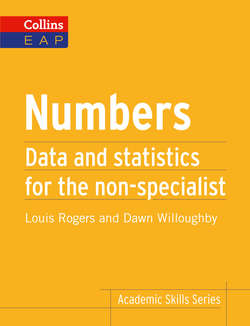Читать книгу Numbers: B2+ - Dawn Willoughby - Страница 4
Contents
ОглавлениеTitle Page
Copyright
Introduction
Chapter 1 Getting started
look at numbers in everyday life
understand the purpose and use of statistics
learn key terms for working with numbers
learn the basics about spreadsheets
practice referring to and labelling graphics in writing
Chapter 2 Starting primary research
practise formulating research questions
understand the principles of sampling
learn how to formulate a hypothesis
Chapter 3 Research methods
understand some common research methods
understand when to use interviews, questionnaires and focus groups
understand the advantages and disadvantages of common research methods
Chapter 4 Questionnaires
understand how to write a questionnaire
practise forming polite question forms
understand different sampling techniques
understand the pros and cons of distribution methods
Chapter 5 Interviews
understand how to ask good interview questions
learn how to structure different questions
learn about the interviewer effect
learn how to use reported speech
Chapter 6 Percentages and fractions
learn how to work with percentages
learn how to understand fractions
compare fractions and percentages
use verbs and nouns and dependent prepositions
Chapter 7 Averages
learn why we use averages
learn about different types of averages
learn when to use frequency tables to find averages
learn how to choose the right average to use
Chapter 8 Presenting your data
understand the use of different visual information
use the present simple, past simple and present perfect to describe graphics
use the active and passive voice to describe graphics
Chapter 9 Describing change
represent change visually
use verbs of change
use adverbs describing change
use adjective and noun combinations to describe change
Chapter 10 Making comparisons
use graphics to compare information
use comparative structures
use superlative structures and cautious language
Chapter 11 Making connections
understand correlation
understand the effect of sample size
express links and connections
describe facts and data
Chapter 12 Working with collected data
learn how to present survey results
avoid producing misleading results from diagrams
describe cause and effect
express generalizations and specifics
use language of argumentation
use evaluative language
learn how to write conclusions
Further reading
The grammar of fractions
Glossary
Answer key
About the Author
About the Publisher
